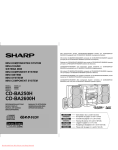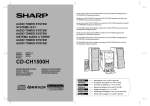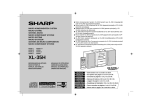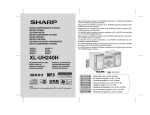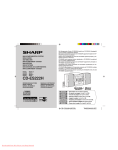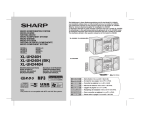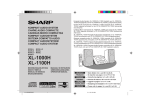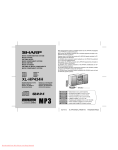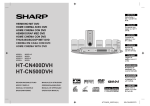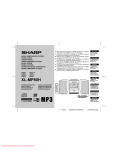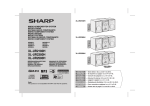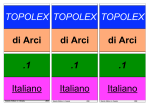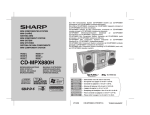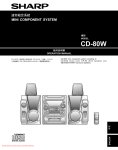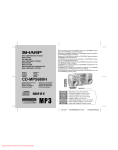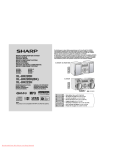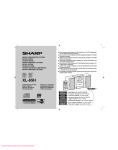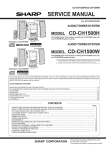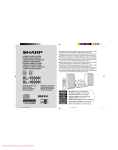Download Sharp CD-CH1500H Specifications
Transcript
Audio Tower System CD-CH1500H besteht aus CD-CH1500H (Hauptgerät) und
CP-RW5500H (Lautsprechersystem).
Système hi-fi CD-CH1500H composé de CD-CH1500H (appareil principal) et de
CP-RW5500H (enceintes acoustiques).
AUDIO TOWER SYSTEM
SYSTÈME HI-FI
AUDIO TOWER SYSTEM
AUDIO TOWER SYSTEM
SISTEMA AUDIO A TORRE
AUDIO TOWER SYSTEM
AUDIO TOWER SYSTEM
MODELL
MODÈLE
MODELO
MODELL
Audio tower system CD-CH1500H que consta de CD-CH1500H (aparato principal)
y CP-RW5500H (sistema de altavoces).
CD-CH1500H Audio Tower System bestående av CD-CH1500H (huvudenhet) och
CP-RW5500H (högtalarsystem).
Sistema audio a torre CD-CH1500H consiste di CD-CH1500H (apparecchio
principale) e CP-RW5500H (diffusori).
CD-CH1500H audio tower system bestaande uit CD-CH1500H (hoofdtoestel) en
CP-RW5500H (luidsprekersysteem).
CD-CH1500H Audio Tower System consisting of CD-CH1500H (main unit) and
CP-RW5500H (speaker system).
MODELLO
MODEL
MODEL
CD-CH1500H
BEDIENUNGSANLEITUNG
MODE D’EMPLOI
MANUAL DE MANEJO
BRUKSANVISNING
MANUALE DI ISTRUZIONI
GEBRUIKSAANWIJZING
OPERATION MANUAL
DEUTSCH
FRANÇAIS
Downloaded From Disc-Player.com Sharp Manuals
Siehe Seiten i bis v und D-1 bis D-38.
Se reporter aux pages i à v et F-1 à F-38.
ESPAÑOL
Consulte las páginas i al v y S-1 al S-38.
SVENSKA
ITALIANO
Hänvisa till sidorna i till v och V-1 till V-38.
Leggere le pagine i a v e I-1 a I-38.
NEDERLANDS
Raadpleeg de bladzijden i t/m v en N-1 t/m N-38.
ENGLISH
Please refer to pages i to v and E-1 to E-38.
BESONDERE ANMERKUNGEN
REMARQUES SPÉCIALES
NOTAS ESPECIALES
SÄRSKILDA ANMÄRKNINGAR
NOTE PARTICOLARI
BIJZONDERE OPMERKINGEN
SPECIAL NOTES
● Dieses Gerät entspricht den Anforderungen der EG-Richtlinien 89/336/
EWG und 73/23/EWG mit Änderung 93/68/EWG.
● Dette udstyr overholder kravene i direktiv nr. 89/336/EEC og 73/23/EEC
med tillaeg nr. 93/68/EEC.
● Este equipamento obedece às exigências das directivas 89/336/CEE e 73/
23/CEE, na sua versão corrigida pela directiva 93/68/CEE.
● Dette produktet oppfyller betingelsene i direktivene 89/336/EEC og 73/23/
EEC i endringen 93/68/EEC.
● Tämä laite täyttää direktiivien 89/336/EEC ja 73/23/EEC vaatimukset, joita
on muutettu direktiivillä 93/68/EEC.
●
● Ce matériel répond aux exigences contenues dans les directives 89/336/
CEE et 73/23/CEE modifiées par la directive 93/68/CEE.
● Este aparato satisface las exigencias de las Directivas 89/336/CEE y
73/23/CEE, modificadas por medio de la 93/68/CEE.
● Denna utrustning uppfyller kraven enligt riktlinjerna 89/336/EEC och 73/
23/EEC så som kompletteras av 93/68/EEC.
● Quest’apparecchio è conforme ai requisiti delle direttive 89/336/EEC e 73/
23/EEC, come emendata dalla direttiva 93/68/EEC.
● Dichiarazione di conformità
La società SHARP ELECTRONICS EUROPE GmbH dichiara che il prodotto
SHARP SISTEMA AUDIO A TORRE CD-CH1500H è costruito in conformità
alle prescrizioni del D.M.n˚548 del 28/8/95, pubblicato sulla G.U.n˚301 del
28/12/95 ed in particolare è conforme a quanto indicato nell’art. 2, comma
1 dello stesso decreto.
● Audio-visuelles Material kann Urheberrechte umfassen, die ohne
Genehmigung des Eigentümers dieser Urheberrechte nicht aufgenommen
werden dürfen. Siehe die entsprechenden nationalen Gesetze.
● Le matériel audio-visuel peut comporter des oeuvres faisant l’objet de droits
d’auteur qui ne peuvent être enregistrées sans l’autorisation du
possesseur du droit d’auteur, veuillez vous référer aux réglementations
nationales en vigueur.
● El material audiovisual puede consistir en trabajos que tengan derechos
de autor y que no deben grabarse sin la autorización del poseedor de dichos
derechos de autor. Sírvase consultar las leyes aplicables en su país.
● Dit apparaat voldoet aan de eisen van de richtlijnen 89/336/EEG en 73/23/
EEG, gewijzigd door 93/68/EEG.
● Audiovisuellt material kan innehålla upphovsrättsarbete som inte skall
mångfaldigas utan tillstånd av copyrightinnehavaren. Se den tillämpliga
lagen i ditt land.
● This equipment complies with the requirements of Directives 89/336/
EEC and 73/23/EEC as amended by 93/68/EEC.
● Il materiale audio-visivo che fosse soggetto a copyright non può essere
registrato senza l’autorizzazione del possessore del copyright. Si prega
di attenersi alle leggi in vigore sul territorio nazionale.
● Audio-visueel materiaal kan worden beschermd door auteursrechten, in
welk geval het niet mag worden opgenomen zonder de toestemming van
de auteursrechthouder. Zie voor nadere informatie de betreffende wetten
in het land van gebruik.
● Audio-visual material may consist of copyrighted works which must not
be recorded without the authority of the owner of the copyright. Please
refer to relevant law in your country.
i
00/12/29
Downloaded From Disc-Player.com Sharp Manuals
COMMON_1500.fm
● B ei E i ns t el l un g d e r O N / STA N D -BY- Ta s t e a u f STA N D -B Y i st d i e
Netzspannung immer noch im Gerät vorhanden.
Wenn die ON/STAND-BY-Taste auf STAND-BY eingestellt wird, kann das
Gerät unter Verwendung der Timer-Betriebsart oder Fernbedienung in
Betrieb gesetzt werden.
Warnung:
In diesem Gerät sind keine vom Benutzer wartbaren Teile vorhanden.
Niemals Abdeckungen entfernen, außer wenn Sie dafür qualifiziert sind. In
diesem Gerät sind gefährliche Spannungen vorhanden. Vor Ausführung
von irgendwelchen Kundendienstarbeiten oder bei längerer Nichtverwendung des Gerätes stets den Netzstecker aus der Netzsteckdose
ziehen.
● Lorsque la touche ON/STAND-BY est mise en STAND-BY, l’appareil est
toujours sous tension.
Lorsque la touche ON/STAND-BY se trouve sur la position STAND-BY,
l’appareil est prêt à fonctionner par la minuterie ou la télécommande.
Avertissement:
Cet appareil contient des pièces non réparables par l’utilisateur. Personne
non qualifiée n’enlèvera jamais les couvercles. L’appareil contenant des
organes portés à haute tension, débrancher l’appareil avant toute réparation
ou en période de non-utilisation.
● Cuando el botón ON/STAND-BY está puesto en la posición STAND-BY,
todavía hay tensión dentro del aparato.
Cuando el botón ON/STAND-BY está puesto en la posición STAND-BY, el
aparato puede ponerse en funcionamiento utilizando el modo del
temporizador o el controlador remoto.
Advertencia:
Tenga en cuenta que dentro de este aparato no hay piezas que pueda
reparar. No quite nunca las tapas a menos que se esté cualificado para
hacerlo. Este aparato tiene en su interior tensiones peligrosas.
Desenchufe siempre la clavija de la red del tomacorriente antes de realizar
cualquier servicio de mantenimiento y cuando no se use el aparato
durante un largo período de tiempo.
● När ON/STAND-BY knappen är i läge STAND-BY, finns nätspänning i
apparaten.
Med ON/STAND-BY knappen i läge STAND-BY kan apparaten startas med
timerfunktion eller fjärrkontrollen.
Varning:
Apparaten innehåller inga delar som kan åtgärdas av kunden. Höljet får
endast öppnas av kvalificerad personal. Apparaten innehåller farliga
spänningar.
Stickkontakten ska därför dras ut från nätuttaget före reparationsarbeten
och bör dras ut om apparaten inte ska användas på mycket länge.
● Quando il tasto ON/STAND-BY si trova in posizione STAND-BY, all’interno
dell’apparecchio c’è ancora la corrente.
Se il tasto ON/STAND-BY si trova nella posizione STAND-BY, l’unità può
venire accesa con il modo timer o con il telecomando.
Avvertenza:
L’apparecchio non contiene parti riparabili dall’utente.
Non togliere mai i coperchi, a meno di non essere qualificati per farlo.
All’interno dell’apparecchio ci sono tensioni pericolose, per cui si deve
sempre staccare la spina del cavo d’alimentazione dalla presa di corrente
prima di qualsiasi intervento di manutenzione e quando non si usa
l’apparecchio per un lungo periodo di tempo.
● Wanneer de ON/STAND-BY toets in de STAND-BY stand staat, loopt er
nog steeds stroom (netspanning) in het toestel.
Wanneer de ON/STAND-BY toets in de STAND-BY stand staat, kan het
toestel ingeschakeld worden via de timerfunctie of de afstandsbediening.
Waarschuwing:
Dit toestel bevat geen door de gebruiker te repareren onderdelen. Verwijder
de behuizing nooit tenzij u deskundig bent op dit gebied. In het toestel
loopt een gevaarlijke spanning; haal de stekker altijd uit het stopcontact
alvorens onderhoud uit te voeren of wanneer het toestel voor langere tijd
niet gebruikt wordt.
● When the ON/STAND-BY button is set at STAND-BY position, mains voltage is still present inside the unit.
When the ON/STAND-BY button is set at STAND-BY position, the unit may
be brought into operation by the timer mode or remote control.
Warning:
This unit contains no user serviceable parts. Never remove covers unless
qualified to do so. This unit contains dangerous voltages, always remove
mains plug from the socket before any service operation and when not
in use for a long period.
● Når ON/STAND-BY-knappen er sat i STAND-BY positionen, er der stadig
netspaending til stede i apparatet.
Når ON/STAND-BY-knappen er sat i STAND-BY position, kan apparatet
startes v.hj.a. timer-funksionen eller fjernbetjeningen.
Advarsel:
Apparatet indeholder ingen dele, der kan repareres af brugeren selv. Fjern
aldrig kabinettet med mindre De er kvalificeret hertil. Apparatet indeholder
farlig strømspaending. Traek altid stikket ud af stikkontakten før der
foretages reparationer, eller hvis apparatet ikke er i brug i laengere tid.
DENNA APPARAT ÄR ANSLUTEN TILL 230 V VÄXELSTRÖM NÄR
STICKPROPPEN ÄR INSKJUTEN I VÄGGUTTAGET. FÖR ATT
FULLSTÄNDIGT KOPPLA IFRÅN APPARATEN, V.G. DRAG UT
STICKPROPPEN.
ii
00/12/29
Downloaded From Disc-Player.com Sharp Manuals
COMMON_1500.fm
● Vorsicht:
Das Gerät weder Tropf- noch Spritzwasser aussetzen. Ansonsten besteht
die Gefahr eines Brandes oder elektrischen Schlages. Es sollten keine mit
Flüssigkeiten gefüllten Gegenstände wie Vasen auf dem Gerät abgestellt
werden.
● Attention:
Pour éviter un incendie ou une secousse électrique, mettre l’appareil à l’abri
d’eau (éclaboussure, goutte). Ne pas poser sur l’appareil un récipient contenant
du liquide.
● Advertencia:
Para evitar incendios y descargas eléctricas, no exponga el aparato a goteo
o salpicadura de líquidos. No deberán ponerse encima del aparato objetos
que estén llenos de líquido, como por ejemplo un florero.
● Advarsel:
Til at forbygge ild og stød risiko, lad vaere med at undsaette denne
indretning for drypning eller overstaenkning. Der må ikke anbringes nogen
genstande fyldt med vand, som for eksempel vaser, på dette apparat.
● Advarsel:
For å unngå brann eller kortslutning, utsett ikke produktet for vann eller
fuktighet. Gjenstander som inneholder vaeske, feks. en blomstervase, må
ikke plasseres oppå apparatet.
● Varoitus:
Älä vie laitetta sateeseen tai kosteisiin tiloihin. Jos laite on kostunut,
anna sen kuivua ennen kuin käytät sitä verkkovirralla. Nestettä sisältäviä
astioita kuten esim. kukkamaljakoita ei saa asettaa laitteen päälle.
● Varning:
Utsätt inte enheten för dropp eller stänk för att förhindra brand eller
elektriska stötar. Inga vätskefyllda föremål såsom vaser bör placeras
på enheten.
● Attenzione:
Per prevenire incendi o scosse elettriche, non fare gocciolare nessun liquido
sull’apperecchio e non bagnarlo. Non collocarvi sopra nessun oggetto
riempiro d’acqua, come peresempio vasi.
● Waarschuwing:
Stel het toestel niet bloot aan druipend of spattend water om brand en
elektrische schokken te voorkomen. Met vloeistoffen gevulde voorwerpen,
zoals vazen, mogen niet op het toestel geplaatst worden.
● Warning:
To prevent fire or shock hazard, do not expose this appliance to dripping or
splashing. No objects filled with liquids, such as vases, shall be placed on
the apparatus.
iii
00/12/29
Downloaded From Disc-Player.com Sharp Manuals
COMMON_1500.fm
● VORSICHT
Verwendung von Regelungen oder Einstellungen bzw. Durchführung von
anderen Verfahren als die hierin angegebenen kann zum Aussetzen
gefährlicher Strahlung führen.
Da der in diesem Compact Disc Player verwendete Laserstrahl für die Augen
schädlich ist, ist das Gehäuse unter keinen Umständen zu zerlegen.
Wenden Sie sich für Wartungsarbeiten nur an berechtigten Fachhändler.
● CAUTION
Use of controls, adjustments or performance of procedures other than
those specified herein may result in hazardous radiation exposure.
As the laser beam used in this compact disc player is harmful to the eyes,
do not attempt to disassemble the cabinet. Refer servicing to qualified personnel only.
● ATTENTION
Respecter les indications données relatives à la manipulation, au réglage
et au fonctionnement. En cas de non-respect, on s’exposera à une radiation dangereuse.
Éviter absolument de démonter l’appareil, qui utilise un rayon laser nuisible
aux yeux. Pour toute réparation, s’adresser à une personne qualifiée.
● PRECAUCIÓN
El uso de los controles, ajustes o ejecución de procedimientos distintos de los
especificados podría causar la exposición a radiación peligrosa.
No intente desmontar la caja ya que el haz de láser usado en este tocadiscos
de discos compactos es perjudicial para los ojos. Para el servicio de reparación,
consulte a una persona cualificada.
● OBSERVERA
Användning av reglage eller justeringar eller handhavande på annat sätt
än som anges kan leda till farlig bestrålning.
Försök inte ta isär höljet eftersom CD-spelarens laserstråle är skadlig för
ögonen. Överlåt service endast till kvalificerad personal.
● ATTENZIONE
L’uso dei comandi e l’effettuazione di regolazioni e procedimenti diversi da
quelli specificati nel manuale possono provocare una pericolosa esposizione
alle radiazioni.
Poiché il raggio laser usato in questo giradischi può danneggiare gli occhi,
non smontare l’apparecchio. Per le riparazioni rivolgersi a personale
specializzato.
● LET OP
Gebruik van regelaars, het maken van instellingen, gebruik of handelingen anders
dan in deze gebruiksaanwijzing vermeld, kan gevaarlijke straling blootleggen.
De laserstraal in deze CD-speler kan de ogen beschadigen, Probeer
derhalve de ombouw niet te verwijderen. Laat reparaties alleen over aan
erkend onderhoudspersoneel.
iv
00/12/29
Downloaded From Disc-Player.com Sharp Manuals
COMMON_1500.fm
Eigenschaften der Laserdiode
Material: GaAIAs
Wellenlänge: 780 nm
Emissionsdauer: kontinuierlich
Laser-Ausgang: max. 0,6 mW
CAUTION-INVISIBLE LASER RADIATION WHEN OPEN. DO NOT STARE INTO
BEAM OR VIEW DIRECTLY WITH OPTICAL INSTRUMENTS.
VARNING-OSYNLIG LASERSTRALNING NAR DENNA DEL AR OPPNAD. STIRRA
EJ IN I STRALEN OCH BETRAKTA EJ STRALEN MED OPTISKA INSTRUMENT.
ADVERSEL-USYNLIG LASERSTRALING VED ABNING. SE IKKE IND I
STRALEN-HELLER IKKE MED OPTISKE INSTRUMENTER.
VARO! AVATTAESSA OLET ALTTIINA NAKYMATON LASERSATEILYLLE.
ALA TUIJOTA SATEESEEN ALAKA KATSO SITA OPTISEN LAITTEEN LAPI.
Caractéristiques de la diode laser
Matière: GaAIAs
Longueur d’onde: 780 nm
Durée d’émission: ininterrompue
Puissance de sortie laser maximale: 0,6 mW
VARNING-OSYNLIG LASERSTRALNING NAR DENNA DEL AR OPPNAD.
STIRRA EJ IN I STRALEN OCH BETRAKTA EJ STRALEN GENOM OPTISKT
INSTRUMENT.
ADVERSEL-USYNLIG LASERSTRALING NAR DEKSEL APNES. STIRR IKKE
INN I STRALEN ELLER SE DIREKTE MED OPTISKE INSTRUMENTER.
Características del diodo láser
Material: GaAIAs
Longitud de onda: 780 nm
Duración de emisión : continua
Salida de láser: máx. 0,6 mW
Laserdiodens egenskaper
Material: GaAIAs
Våglängd: 780 nm
Utstrålningsvaraktighet: kontinuerlig
Lasereffekt: max. 0,6 mW
Proprietà del diodo laser
Materiale: GaAIAs
Lunghezza d’onda: 780 nm
Durata di emissione: continua
Uscita massima del laser: 0,6 mW
Laser diode specificaties
Materiaal: GaAIAs
Golflengte: 780 nm
Stralingsduur: doorlopend
Laseruitgang: max. 0,6 mW
Laser Diode Properties
Material: GaAIAs
Wavelength: 780 nm
Emission Duration: continuous
Laser Output: max. 0.6 mW
VAROITUS! LAITTEEN KÄYTTÄMINEN MUULLA KUIN TÄSSÄ
KÄYTTÖOHJEESSA MAINITULLA TAVALLA SAATTAA ALTISTAA
KÄYTTÄJÄN TURVALLISUUSLUOKAN 1 YLITTÄVÄLLE NÄKYMÄTTÖMÄLLE
LASERSÄTEILYLLE.
VARNING - OM APPARATEN ANVÄNDS PÅ ANNAT SÄTT ÄN I DENNA
BRUKSANVISNING SPECIFICERAS. KAN ANVÄNDAREN UTSÄTTAS FÖR
OSYNLIG LASERSTRÅLNING, SOM ÖVERSKRIDER GRÄNSEN FÖR
LASERKLASS 1.
v
00/12/29
Downloaded From Disc-Player.com Sharp Manuals
COMMON_1500.fm
ENGLISH
Introduction
Thank you for purchasing this SHARP product. To obtain the best performance from
this product, please read this manual carefully. It will guide you in operating your
SHARP product.
Page
Precautions . . . . . . . . . . . . . . . . . . . . . . . . . . . . . . . . . . . . . . . . . . . . . . . . . . . . 2 - 3
Accessories . . . . . . . . . . . . . . . . . . . . . . . . . . . . . . . . . . . . . . . . . . . . . . . . . . . . . . .3
Controls and Indicators . . . . . . . . . . . . . . . . . . . . . . . . . . . . . . . . . . . . . . . . . . . 4 - 7
„ Preparation for Use
System Connections . . . . . . . . . . . . . . . . . . . . . . . . . . . . . . . . . . . . . . . . . . . . . 8 - 9
Remote Control . . . . . . . . . . . . . . . . . . . . . . . . . . . . . . . . . . . . . . . . . . . . . . . . . . .10
„ Basic Operation
General Control . . . . . . . . . . . . . . . . . . . . . . . . . . . . . . . . . . . . . . . . . . . . . . . . . . .11
Sound Control . . . . . . . . . . . . . . . . . . . . . . . . . . . . . . . . . . . . . . . . . . . . . . . . . . . .12
Setting the Clock . . . . . . . . . . . . . . . . . . . . . . . . . . . . . . . . . . . . . . . . . . . . . . . . . .13
„ CD Playback
Listening to a CD (CDs) . . . . . . . . . . . . . . . . . . . . . . . . . . . . . . . . . . . . . . . . . 14 - 15
„ Advanced CD Playback
To Specify a Disc to Play . . . . . . . . . . . . . . . . . . . . . . . . . . . . . . . . . . . . . . . . . . . .16
Switching the Time Display . . . . . . . . . . . . . . . . . . . . . . . . . . . . . . . . . . . . . . . . .16
Repeat or Random Play . . . . . . . . . . . . . . . . . . . . . . . . . . . . . . . . . . . . . . . . . . . . .16
Programmed Play . . . . . . . . . . . . . . . . . . . . . . . . . . . . . . . . . . . . . . . . . . . . . . . . .17
Page
„ Radio
Listening to the Radio . . . . . . . . . . . . . . . . . . . . . . . . . . . . . . . . . . . . . . . . . . . . . . 18
Listening to the Memorised Station . . . . . . . . . . . . . . . . . . . . . . . . . . . . . . . . . . . 19
„ RDS Radio
Using the Radio Data System (RDS) . . . . . . . . . . . . . . . . . . . . . . . . . . . . . . 20 - 27
„ Tape Playback
Listening to a Cassette Tape . . . . . . . . . . . . . . . . . . . . . . . . . . . . . . . . . . . . . . . . 28
„ Recording
Recording to a Cassette Tape from a CD . . . . . . . . . . . . . . . . . . . . . . . . . . . . . . 29
Recording to a Cassette Tape from the Radio . . . . . . . . . . . . . . . . . . . . . . . . . . 30
„ Advanced Features
Timer and Sleep Operation . . . . . . . . . . . . . . . . . . . . . . . . . . . . . . . . . . . . . . 31 - 33
Enhancing Your Stereo System . . . . . . . . . . . . . . . . . . . . . . . . . . . . . . . . . . 34 - 35
„ References
Troubleshooting Chart . . . . . . . . . . . . . . . . . . . . . . . . . . . . . . . . . . . . . . . . . 36 - 37
Maintenance . . . . . . . . . . . . . . . . . . . . . . . . . . . . . . . . . . . . . . . . . . . . . . . . . . . . . . 37
Specifications . . . . . . . . . . . . . . . . . . . . . . . . . . . . . . . . . . . . . . . . . . . . . . . . . . . . 38
ENGLISH
01/1/9
Downloaded From Disc-Player.com Sharp Manuals
-Introduction/Contents-
„ General Information
Important Instruction
Contents
E1.fm
E-1
Precautions
„ General
z Please ensure that the equipment is positioned in a well-ventilated area and
ensure that there is at least 20 cm (8") of free space along the sides, top and back
of the equipment.
20 cm (8")
20 cm (8")
20 cm (8")
z Use the unit on a firm, level surface free from
vibration.
-Precautions-
General Information
20 cm (8")
z Keep the unit away from direct sunlight,
strong magnetic fields, excessive dust, humidity and electronic/electrical equipment
(home computers, facsimiles, etc.) which
generates electrical noise.
z Do not place anything on top of the unit.
z Do not expose the unit to moisture, to temperatures higher than 60°C (140°F) or to
extremely low temperatures.
z If your system does not work properly, disconnect the AC power lead from the wall
socket. Plug the AC power lead back in, and then turn on your system.
z In case of an electrical storm, unplug the unit
for safety.
E-2
z Hold the AC power plug by the head when removing it from the wall socket, as pulling the
lead can damage internal wires.
z Do not remove the outer cover, as this may
result in electric shock. Refer internal service to your local SHARP service facility.
z The ventilation should not be impeded by covering the ventilation openings with items, such
as newspapers, tablecloths, curtains, etc.
z No naked flame sources, such as lighted candles, should be placed on the apparatus.
z Attention should be drawn to the environmental aspects of battery disposal.
z The apparatus is designed for use in moderate climate.
z This unit should only be used within the range of 5°C - 35°C (41°F - 95°F).
Warning:
The voltage used must be the same as that specified on this unit. Using this product
with a higher voltage other than that which is specified is dangerous and may result in
a fire or other type of accident causing damage. SHARP will not be held responsible
for any damage resulting from use of this unit with a voltage other than that which is
specified.
„ Volume control
The sound level at a given volume setting depends on speaker efficiency, location,
and various other factors. It is advisable to avoid exposure to high volume levels,
which occur whilst turning the unit on with the volume control setting up high, or
whilst continually listening at high volumes.
ENGLISH
01/1/9
Downloaded From Disc-Player.com Sharp Manuals
E1.fm
Accessories
„ Care of compact discs
Please confirm that the following accessories are included.
Compact discs are fairly resistant to damage, however mistracking can occur due to
an accumulation of dirt on the disc surface. Follow the guidelines below for maximum
enjoyment from your CD collection and player.
z Do not write on either side of the disc, particularly the non-label side from which
signals are read. Do not mark this surface.
z Keep your discs away from direct sunlight, heat, and excessive moisture.
z Always hold the CDs by the edges. Fingerprints, dirt, or water on the CDs can
cause noise or mistracking. If a CD is dirty or does not play properly, clean it with a
soft, dry cloth, wiping straight out from the centre, along the radius.
1
AM loop aerial
1
"AA" size battery (UM/SUM-3, R6, HP-7
or similar) 2
FM aerial
A
„ Cassette tape
: Blue
B
z For playback, use normal or low-noise tapes for the best sound. (Metal or
CrO tapes are not recommended.) For recording, use only normal tapes.
z Do not use C-120 tapes or poor-quality tapes, as they may cause malfunctions.
z Before loading a tape into the cassette compartment, tighten the slack with a pen
or a pencil.
: Black
Speaker wire for MAIN terminals
A
2
: Red
B
: Black
Speaker wire for SUBWOOFER terminals
Cassettes have removable tabs which prevent accidental recording or erasing.
Removing the tab will protect the corresponding side. Cover the tab holes with adhesive tape to erase or record again.
1
-Precautions/Accessories-
YES
correct
General Information
NO
Remote control
2
Note:
Only the above accessories are included.
Side A (1)
Tab for side B (2)
Tab for side A (1)
ENGLISH
01/1/9
Downloaded From Disc-Player.com Sharp Manuals
E1.fm
E-3
Controls and Indicators
„ Front panel
Reference page
1
3
4
-Controls and Indicators-
General Information
2
5
6
9
10
11
12
13
7
8
17 18 19 20 21
22
23
24
25
E-4
26
27
28
29
1. Cassette Compartment . . . . . . . . . . . . . . . . . . . . . . . . . . . . . . . . . . .28
2. Volume Up/Demo Button . . . . . . . . . . . . . . . . . . . . . . . . . . . . . . .11, 12
3. Volume Down Button . . . . . . . . . . . . . . . . . . . . . . . . . . . . . . . . . . . . .12
4. Timer Set Indicator . . . . . . . . . . . . . . . . . . . . . . . . . . . . . . . . . . . . . .32
5. On/Stand-by Button . . . . . . . . . . . . . . . . . . . . . . . . . . . . . . . . . . . . . .11
6. CD Direct Play Buttons (with Indicator)/CD Eject Buttons . . .14, 16
7. Disc Trays . . . . . . . . . . . . . . . . . . . . . . . . . . . . . . . . . . . . . . . . . . . . . .14
8. Headphone Socket . . . . . . . . . . . . . . . . . . . . . . . . . . . . . . . . . . . . . . .35
9. Control Panel Open/Close Button . . . . . . . . . . . . . . . . . . . . . . . . . .11
10.CD Play Mode Select Button . . . . . . . . . . . . . . . . . . . . . . . . . . . . . . .16
11.Equalizer Mode Select Button . . . . . . . . . . . . . . . . . . . . . . . . . . . . .12
12.Extra Bass Button . . . . . . . . . . . . . . . . . . . . . . . . . . . . . . . . . . . . . . .12
13.Display Button . . . . . . . . . . . . . . . . . . . . . . . . . . . . . . . . . . . . . . .13, 31
14.Menu Button . . . . . . . . . . . . . . . . . . . . . . . . . . . . . . . . . . . . . .13, 31, 33
15.Jog Dial . . . . . . . . . . . . . . . . . . . . . . . . . . . . . . . . .13, 15, 17, 19, 31, 33
16.Enter Button . . . . . . . . . . . . . . . . . . . . . . . . . . . . . . . . . . .13, 19, 31, 33
17.CD Button . . . . . . . . . . . . . . . . . . . . . . . . . . . . . . . . . . . . . . . .14, 29, 32
18.Tape Button . . . . . . . . . . . . . . . . . . . . . . . . . . . . . . . . . . . . . .28, 30, 32
19.Tuner (Band) Button . . . . . . . . . . . . . . . . . . . . . . . . . . . . . . . . . .18, 32
20.Auxiliary Button . . . . . . . . . . . . . . . . . . . . . . . . . . . . . . . . . . . . . . . . .34
21.Tape Reverse Mode Select Button . . . . . . . . . . . . . . . . . . . . . . .28, 29
22.Clear Button . . . . . . . . . . . . . . . . . . . . . . . . . . . . . . . . . . . . . . . . .17, 19
23.Memory Button . . . . . . . . . . . . . . . . . . . . . . . . . . . . . . . . . . . . . . . . .17
24.CD Fast Reverse, Tape Fast Wind or Tuning Down Button
(with Indicator) . . . . . . . . . . . . . . . . . . . . . . . . . . . . . . . . .15, 18, 28, 34
25.Tape Reverse Play Button (with Indicator) . . . . . . . . . . . . .28, 29, 34
26.CD Fast Forward, Tape Fast Wind or Tuning Up Button
(with Indicator) . . . . . . . . . . . . . . . . . . . . . . . . . . . . . . . . .15, 18, 28, 34
27.Tape Record Pause Button . . . . . . . . . . . . . . . . . . . . . . . . . . . . .29, 34
28.Stop Button (with Indicator) . . . . . . . . . . . . . . . . . . . . . . . . .15, 17, 29
29.CD Play or Pause, Tape Forward Play Button
(with Indicator) . . . . . . . . . . . . . . . . . . . . . . . . . . . . . . . . .15, 28, 29, 30
14 15 16
ENGLISH
01/1/9
Downloaded From Disc-Player.com Sharp Manuals
E1.fm
2
3
4
5
6
7
8
9 10 11
12
20
21
22
23
24
1
5
2
3
4
6
1. Function Indicator
2. Extra Bass Indicator
3. Random Play Indicator
4. Memory Indicator
5. Total Indicator
6. Remain Indicator
7. Timer Play Indicator
8. Sleep Indicator
9. Timer Recording Indicator
10.All Disc Play Indicator
11.Cassette Indicator
12.Level Meter
13.CD Indicators
14.CD Repeat Indicator
15.CD Pause Indicator
16.CD Play Indicator
17.FM Stereo Indicator
18.Tape Reverse Mode Indicator
19.FM Stereo Mode Indicator
20.RDS Indicator
21.Radio Text Indicator
22.Clock Time Indicator
23.Dynamic PTY Indicator
24.Traffic Programme Indicator
25.EON Indicator
26.Traffic Information Indicator
27.Programme Type Indicator
28.Traffic Announcement Indicator
General Information
13
14
15
16
17
18
19
25
26
27
28
1
-Controls and Indicators-
„ Multi-function LCD display
„ Rear panel
Reference page
7
1. AM Loop Aerial Socket . . . . . . . . . . . . . . . . . . . . . . . . . . . . . . . . . . . . 8
2. FM Aerial Terminal . . . . . . . . . . . . . . . . . . . . . . . . . . . . . . . . . . . . . . . 8
3. Auxiliary Input Sockets . . . . . . . . . . . . . . . . . . . . . . . . . . . . . . . . . . . 34
4. CD Digital Output Socket . . . . . . . . . . . . . . . . . . . . . . . . . . . . . . . . . 35
5. Speaker Terminals . . . . . . . . . . . . . . . . . . . . . . . . . . . . . . . . . . . . . . . 8
6. AC Power Lead . . . . . . . . . . . . . . . . . . . . . . . . . . . . . . . . . . . . . . . . . . 8
7. Transport screw . . . . . . . . . . . . . . . . . . . . . . . . . . . . . . . . . . . . . . . 8, 37
ENGLISH
01/1/9
Downloaded From Disc-Player.com Sharp Manuals
E1.fm
E-5
Controls and Indicators (continued)
„ Remote control
-Controls and Indicators-
General Information
Reference page
1
15
2
16
3
4
17
5
19
6
7
20
8
9
18
21
22
11
23
24
25
12
26
13
14
27
28
10
29
30
E-6
1. Remote Control Transmitter . . . . . . . . . . . . . . . . . . . . . . . . . . . . . . .10
2. Tuner (Band) Button
3. CD Button
4. Auxiliary Button
5. CD Direct Play Buttons
6. Clear Button
7. Memory Button
8. CD Track Down or Fast Reverse, Tape Fast Wind, Tuner Preset
Down Button
9. Enter Button
10.Stop Button
11.Menu Button
12.Time Button . . . . . . . . . . . . . . . . . . . . . . . . . . . . . . . . . . . . . . . . .16, 27
13.FM Stereo Mode Button . . . . . . . . . . . . . . . . . . . . . . . . . . . . . . . . . .18
14.Control Panel Open/Close Button
15.Tape Button
16.On/Stand-by Button
17.RDS Programme Type/Traffic Information Search Button . . . 23 - 25
18.RDS EON Button . . . . . . . . . . . . . . . . . . . . . . . . . . . . . . . . . . . . .24, 25
19.RDS ASPM (Auto Station Programme Memory) Button . . . . . . . . .22
20.RDS Display Mode Selector Button . . . . . . . . . . . . . . . . . . .20, 24, 27
21.CD Play Mode Select Button
22.CD Track Up or Fast Forward, Tape Fast Wind, Tuner Preset Up Button
23.CD Play or Pause, Tape Play Button
24.Tape Record Pause Button
25.Tape Reverse Mode Select Button
26.Dimmer Button . . . . . . . . . . . . . . . . . . . . . . . . . . . . . . . . . . . . . . . . . .11
27.Display Button
28.Equalizer Mode Select Button
29.Extra Bass Button
30.Volume Up or Down Buttons
Buttons with " " mark in the illustration can be operated on the remote control only.
Other buttons can be operated both on the main unit and the remote control.
ENGLISH
01/1/9
Downloaded From Disc-Player.com Sharp Manuals
E1.fm
„ Speaker system
Speaker grilles are removable:
Make sure nothing comes into contact with
the speaker diaphragms when you remove
the speakers grilles.
Left speaker
Right speaker
2
4
5
3
Bi-amp system:
6
1. Woofer
2. Tweeter
3. Subwoofer
4. Subwoofer Terminals
5. Main Speaker Terminals
6. Bass Reflex Duct
Each speaker unit has a built-in subwoofer (low frequency range) which is driven separately from the woofer and tweeter (mid-to-high frequency range). Two independent
amplifiers which have individual frequency characteristics are used. By amplifying
separately the two frequency bands, clearer sound is achieved.
Woofer
Tweeter
Power amplifier
Pre-amplifier
Subwoofer
Mid-to-high range
(200 Hz - 20 kHz)
Ultra-low range
(60 Hz - 200 Hz)
L-ch
ENGLISH
01/1/9
Downloaded From Disc-Player.com Sharp Manuals
E1.fm
-Controls and Indicators-
Placing the speaker system:
There is no distinction between the right
and the left speakers.
General Information
1
E-7
System Connections
Not supplied
FM aerial
AM loop aerial
VCR, DVD, etc.
MiniDisc
Recorder
-System Connections-
Preparation for Use
Not supplied
Left
speaker
Right
speaker
Wall socket
(AC 230 V, 50 Hz)
Transport screw
E-8
ENGLISH
Enhancing Your Stereo System (See pages 34 - 35.)
01/1/9
Downloaded From Disc-Player.com Sharp Manuals
E1.fm
„ Removing the transport screw
„ Speaker connection
„ Aerial connection
Subwoofer terminals:
Connect the red wire to the (+) and the black one to the (-).
Main terminals:
Connect the blue wire to the (+) and the black one to the (-).
Right speaker
Left speaker
Supplied AM loop aerial:
Connect the AM loop aerial to the AM LOOP socket. Position the AM loop aerial for
optimum reception. Place the AM loop aerial on a shelf, etc., or attach it to a stand or
a wall with screws (not supplied).
1
Blue
Notes:
z Placing the aerial on the stereo system or near the AC power lead may cause
noise pickup. Place the aerial away from the stereo system for better reception.
z Do not connect the attached FM aerial to an external FM aerial. Otherwise, trouble
may occur.
Installing the AM loop aerial:
Assembling
Black
2
3
Red
Caution:
z Connect the speaker wires to the speakers first, then to the unit.
z Never mistake the MAIN and the SUBWOOFER terminals. The stereo system or
the speakers may be damaged.
z Only the included speakers should be used with this product. Do not use other
speakers with this unit or use the supplied speakers with other units.
z Do not mistake the right channel for the left channel when connecting the speakers
to the unit. The right speaker is the one on the right side when you are facing the
front of the unit.
z Do not let the bare speaker wires touch each other.
Attaching to the wall
Wall
Screws
External FM aerial:
Use an external FM aerial if you require better reception. Consult your dealer.
External FM aerial
Incorrect
-System Connections-
Supplied FM aerial:
Connect the FM aerial wire to the FM 75 OHMS socket and position the FM aerial
wire in the direction where the strongest signal can be received.
Preparation for Use
Before turning the power on, be sure to remove the transport screw on the
back of the unit using a flat-blade screwdriver or a coin.
This screw is required when transporting the unit again. Please keep it (see page 37).
Incorrect
z Do not stand or sit on the speakers. You may be injured.
„ Connecting the AC power lead
After checking all the connections have been made correctly, plug the AC power lead of this
unit into the AC socket. If you plug in the unit first, the unit will enter the demonstration
mode.
Note:
Unplug the unit if it will not be used for a prolonged period of time.
Demonstration mode (See page 11.)
01/1/9
Downloaded From Disc-Player.com Sharp Manuals
E1.fm
ENGLISH
E-9
Remote Control
„ Battery installation
1 Remove the battery cover.
2 Insert the supplied batteries according to the direction indicated in
the battery compartment.
z When inserting or removing the batteries, push them towards the
nal.
-Remote Control-
Preparation for Use
3
E-10
battery termi-
„ Test of the remote control
Face the remote control directly to the remote sensor on the unit.
The remote control can be used within the range shown below:
Press the ON/STAND-BY button. Does the power turn on? Now, you can enjoy the
music.
Remote sensor
Replace the cover.
Precautions for battery use:
z Replace all old batteries with new ones at the same time.
z Do not mix old and new batteries.
z Remove the batteries if the unit will not be used for long periods of time. This will
prevent potential damage due to battery leakage.
Caution:
z Do not use rechargeable batteries (nickel-cadmium battery, etc.).
z Installing the batteries incorrectly may cause the unit to malfunction.
Notes concerning use:
z Replace the batteries if the operating distance is reduced or if the operation
becomes erratic. Purchase 2 "AA" size batteries (UM/SUM-3, R6, HP-7 or similar).
z Periodically clean the transmitter on the remote control and the sensor on the stereo system with a soft cloth.
z Exposing the sensor on the stereo system to strong light may interfere with operation. Change the lighting or the direction of the stereo system.
z Keep the remote control away from moisture, heat, shock, and vibrations.
0.2 m - 6 m (8" - 20')
ENGLISH
01/1/9
Downloaded From Disc-Player.com Sharp Manuals
E1.fm
General Control
„ Opening and closing the control panel
The control panel is motorised.
The control panel automatically opens when the power is turned on, and closes when
the unit is set to the power stand-by mode.
When the power is turned on, you can open or close the control panel by pressing the
control panel open/close button.
You can switch the display brightness by pressing the DIMMER button.
Dimmer off
Dimmer on
„ Demonstration mode
-General Control-
„ Display brightness (2 levels)
Basic Operation
Caution:
z Do not push the control panel whilst it is opening or closing.
z Do not press buttons on the control panel strongly. The hinge of the panel may be
broken.
z Be careful not to jam your fingers in the control panel.
The first time the unit is plugged, the unit will enter the demonstration mode. You will
see words scroll.
To cancel the demonstration mode:
When the unit is in the power stand-by mode (demonstration mode), press the DEMO
button. The unit will enter the low power consumption mode.
To return to the demonstration mode:
When the unit is in the power stand-by mode, press the DEMO button again.
ENGLISH
01/1/9
Downloaded From Disc-Player.com Sharp Manuals
E2.fm
E-11
Sound Control
„ Bass control
When the X-BASS button is pressed, the unit will enter the extra bass mode which
emphasises the bass frequencies, and "X-BASS" will appear. To cancel the extra
bass mode, press the X-BASS button.
Cancelled.
„ Equalizer
When the EQUALIZER button is pressed, the current mode setting will be displayed.
To change to a different mode, press the EQUALIZER button repeatedly until the
desired sound mode appears.
-Sound Control-
Basic Operation
Bass is emphasised.
„ Volume control
Press the VOLUME
decreasing.
E-12
button to increase the volume and the VOLUME
The sound is not modified.
Bass and treble are emphasised.
Treble is reduced.
Vocals (midrange tones) are
emphasised.
button for
ENGLISH
01/1/9
Downloaded From Disc-Player.com Sharp Manuals
E2.fm
Setting the Clock
5
Turn the jog dial to adjust the hour and within 2 minutes, press the
ENTER button.
z When the 12-hour display is selected, "AM" will change automatically to "PM".
In this example, the clock is set for the 24-hour (0:00) display.
z The hour will not advance even if minutes advance from "59" to "00".
z The clock starts from "0" second. (Seconds are not displayed.) The time display
will disappear after a few seconds.
1
2
3
To confirm the time display:
[When the unit is in the stand-by mode]
Press the DISPLAY button on the remote control. The
time display will appear for about 3 seconds.
4
Press the ON/STAND-BY button to turn the power on.
Press the MENU button.
Turn the jog dial to select "CLOCK" and within 10 seconds, press
the ENTER button.
Turn the jog dial to select the 24-hour or 12-hour display and within
2 minutes, press the ENTER button.
"0:00"
"AM 12:00"
"AM 0:00"
The 24-hour display will appear.
(0:00 - 23:59)
The 12-hour display will appear.
(AM 12:00 - PM 11:59)
The 12-hour display will appear.
(AM 0:00 - PM 11:59)
Note that this can only be set when the unit is first installed or it has been reset.
[Refer to "Clearing all the memory (reset)" on page 37 for details.]
[When the power is on]
Press the MENU button. The time display will appear
for about 10 seconds.
Note:
"CLOCK" will appear or time will flash at the push of the DISPLAY button when the
AC power supply is restored after a power failure or unplugging the unit. Reset the
clock as follows.
To reset the clock:
[When time is flashing]
1 Press the ON/STAND-BY button.
2 Press the MENU button.
3 Press the ENTER button.
4 Perform "Setting the Clock" from step 5.
[When "CLOCK" appears]
Perform "Setting the Clock" from the beginning.
To change the 24-hour or 12-hour display:
1 Clear all the programmed contents. [Refer to "Clearing all the memory (reset)"
on page 37 for details.]
2 Perform "Setting the Clock" from the beginning.
ENGLISH
01/1/9
Downloaded From Disc-Player.com Sharp Manuals
-Setting the Clock-
Turn the jog dial to adjust the minutes and within 2 minutes, press
the ENTER button.
Basic Operation
6
E2.fm
E-13
Listening to a CD (CDs)
This system can play audio CD-R and CD-RW discs just as CD discs, but cannot perform recording.
5
Press the DISC 1
button to close the disc tray 1.
Means "disc inside"
CD Playback
-Listening to a CD (CDs)-
Total number of tracks
6
Note:
The system will search CD trays until it finds a CD and will not search the rest of
trays.
7
Press the
button to start playback.
„ To play discs in turn (from Disc 1 to Disc 6)
1 Press the ON/STAND-BY button to turn the power on.
2 Press the CD button.
3 Press the DISC 1 button to open the disc tray 1.
4 Place a CD on the disc tray 1, label side up.
z Be sure to place 8 cm (3") CD in the middle of the disc trays.
12 cm (5")
E-14
Total playing time
You can place discs on the trays 2 - 6 by following steps 3 - 5.
ENGLISH
8 cm (3")
z Playback will begin from track 1 on the DISC 1. After that disc finishes playing, the
next disc will automatically start playback.
z When there is no CD in one of the disc tray 1 - 6 positions, that position will be
skipped and the next CD will be played.
z When the last track on the DISC 6 has finished playing, the CD player will stop
automatically.
Sound Control (See page 12.)
01/1/9
Downloaded From Disc-Player.com Sharp Manuals
E2.fm
To interrupt playback:
Press the
button.
To resume playback from the same point, press the
„ To locate the beginning of a track
button again.
To move to the beginning of the next track:
Turn the jog dial slowly clockwise by one position during playback.
To stop playback:
Press the button.
To exchange other CDs whilst playing a disc:
Press the button for the stopped disc and exchange discs.
z You can skip to any track by turning the jog dial until the desired track number
appears.
button.
Caution:
z Do not place two CDs in one disc tray.
z Do not push the disc tray whilst it is moving.
z If the power fails whilst the tray is open, wait until the power is restored.
z If the disc tray is stopped forcibly, "E-CD20" will appear in the display and the unit
will not function. If this occurs, press the ON/STAND-BY button to enter the power
stand-by mode and then turn the power on again.
z If TV or radio interference occurs during CD operation, move the unit away from
the TV or radio.
z If a disc is damaged, dirty, or loaded upside down, the disc will be skipped.
To restart the track being played:
Turn the jog dial slowly anti-clockwise by one position during playback.
z You can skip to any track by turning the jog dial until the desired track number
appears.
Notes:
z You can locate the beginning of a track on a single disc only.
z The
or
button on the remote control allows you to locate the beginning of a
track.
„ To locate the desired portion
For audible fast forward:
Press and hold down the
button during playback.
For audible fast reverse:
Press and hold down the
button during playback.
CD Playback
After use:
Press the ON/STAND-BY button to enter the power stand-by mode.
-Listening to a CD (CDs)-
To remove the CDs:
Whilst in the stop mode, press the desired
Notes:
z Normal playback will resume when the
or
button is released.
z When the end of the last track is reached during fast forward, "DISC END" will
appear on the display and CD operation will be paused. When the beginning of the
first track is reached during fast reverse, the disc will start playback automatically.
z You can locate the desired portion on a single disc only.
ENGLISH
01/1/9
Downloaded From Disc-Player.com Sharp Manuals
E2.fm
E-15
Advanced CD Playback
-To Specify a Disc to Play / Switching the Time Display / Repeat or Random Play-
E-16
To Specify a Disc to Play
Repeat or Random Play
You can play a disc by specifying the disc number.
You can select one of the CD playback modes; "Repeat play", "Random play" and
"Normal play".
Press one of the DISC 1 - DISC 6 buttons to play the desired disc.
1
Press the PLAY MODE button repeatedly to select the playback
mode.
Selected disc number
z Only the chosen disc will be played and stopped automatically.
Repeat playback mode
Random playback mode
Note:
When one of the DISC 1 - DISC 6 buttons is green, it is ready to play that disc. If
there is not a disc on the tray, playback will not begin and the button will turn dark.
To stop playback:
Press the button.
Switching the Time Display
Normal playback mode
2
Press the
or one of the DISC 1 - DISC 6 buttons to start playback.
Each time the TIME button on the remote control is pressed during playback or
when in the pause mode, the display will change.
The elapsed playing time for
the current track will be displayed.
The remaining playing time
for the current track will be
displayed.
The total remaining playing
time for the disc will be displayed.
z If playback is started by pressing the
button, repeat or random play will be performed on all discs.
z If playback is started by pressing one of the DISC 1 - DISC 6 buttons, repeat or
random play will be performed on that disc.
To repeat a programmed sequence:
Perform steps 1 - 6 in the "Programmed Play" section, select the repeat playback and
then press the
button.
Notes:
z After performing repeat or random play, be sure to press the button. Otherwise,
the disc(s) will play continuously.
z In random play, the CD player will select and play tracks automatically. (You cannot
select the order of the tracks.)
To cancel repeat or random play:
Press the PLAY MODE button repeatedly to select the normal play mode.
Notes:
z During random play, the total remaining playing time will not be displayed.
z Depending on the CD, the playing time display may not match the total playing
time which is indicated on the CD jacket, as the time between tracks is not
included.
ENGLISH
01/1/9
Downloaded From Disc-Player.com Sharp Manuals
E2.fm
Programmed Play
By specifying discs from 1 to 6, and tracks from 1 to 99, you can choose up to 32
selections for playback in the order you like.
1
6
7
Press the
Press the
button.
button to start playback.
When in the stop mode, press the MEMORY button.
Press one of the DISC 1 - DISC 6 buttons to select the desired disc.
Selected disc number
To clear the programmed selections:
Press the CLEAR button whilst the "MEMORY" indicator is flashing.
Each time the button is pressed, one track will be cleared, beginning with the last
track programmed.
To cancel the programmed play mode:
Whilst in the stop mode, press the CLEAR button. The MEMORY indicator will disappear and all the programmed content will be cleared.
3
Adding tracks to the programme:
If a programme has been previously stored, the "MEMORY" indicator will be displayed. Then follow steps 1 - 6 to add tracks. The new tracks will be stored after the
last track of the original programme.
Turn the jog dial to select the desired track.
To check which tracks are programmed:
Whilst the unit is stopped in the programmed play mode, press the
Selected track number
Playback order
4
Press the MEMORY button to save the track number.
5
Repeat steps 2 - 4 for other tracks. Up to 32 tracks can be programmed.
or
button.
Notes:
z Opening any tray of the programmed discs automatically cancels the programmed
sequence.
z Even if you press the ON/STAND-BY button to enter the stand-by mode or change
the function from CD to another function, the programmed selections will not be
cleared.
z During programme operation, random play is not possible.
-Programmed Play-
2
Advanced CD Playback
z At this time, playback will not begin even if one of the DISC 1 - DISC 6 buttons is
pressed.
Playback time
ENGLISH
01/1/9
Downloaded From Disc-Player.com Sharp Manuals
E2.fm
E-17
Listening to the Radio
1
2
Press the ON/STAND-BY button to turn the power on.
3
Press the TUNING (
Press the TUNER (BAND) button repeatedly to select the desired
frequency band (FM or AM).
Manual tuning:
Press the TUNING (
desired station.
or
or
) button to tune in to the desired station.
) button as many times as required to tune in to the
Notes:
z When radio interference occurs, auto scan tuning may stop automatically at that
point.
z Auto scan tuning will skip weak signal stations.
z To stop the auto tuning, press the TUNING ( or ) button again.
z When an RDS (Radio Data System) station is tuned in, the frequency will be displayed first, and then the RDS indicator will light. Finally, the station name will
appear.
z Full auto tuning can be achieved for RDS stations "ASPM", see page 22.
-Listening to the Radio-
Radio
Auto tuning:
When the TUNING ( or ) button is pressed for more than 0.5 seconds, scanning
will start automatically and the tuner will stop at the first receivable broadcast station.
To receive an FM stereo transmission:
Press the ST-MODE button on the remote control to display the "ST" indicator.
z " " will appear when an FM broadcast is in stereo.
FM Stereo Mode Indicator
FM stereo receiving indicator
z If the FM reception is weak, press the ST-MODE button. The "ST" indicator goes
out. The reception changes to monaural, and the sound becomes clearer.
After use:
Press the ON/STAND-BY button to enter the power stand-by mode.
E-18
ENGLISH
Sound Control (See page 12.)
01/1/9
Downloaded From Disc-Player.com Sharp Manuals
E2.fm
Listening to the Memorised Station
„ Memorising a station
„ To recall a memorised station
You can store 40 AM and FM stations in memory and recall them at the push of a button. (Preset tuning)
Turn the jog dial to select the desired station.
Perform steps 1 - 3 in the "Listening to the Radio" section on page
18.
2
Press the ENTER button to enter the preset tuning saving mode.
Note:
The PRESET (
station.
or
) button on the remote control allows you to recall a memorised
„ To scan the preset stations
Within 5 seconds, turn the jog dial to select the preset channel
number.
The stations saved in memory can be scanned automatically. (Preset memory scan)
1
Press the PRESET (
than 0.5 seconds.
or
Press the PRESET (
is located.
or
) button on the remote control for more
z The preset number will flash and the programmed stations will be tuned in
sequentially, for 5 seconds each.
z Store the stations in memory, in order, starting with preset channel 1.
z When " " is displayed, a station has already been stored in memory.
4
Within 5 seconds, press the ENTER button to store that station in
memory.
2
z If the "MEMORY" and preset number indicators go out before the station is memorised, repeat the operation from step 2.
5
Repeat steps 1 - 4 to set other stations, or to change a preset station.
z When a new station is stored in memory, the station previously memorised will be
erased.
Note:
The backup function protects the memorised stations for a few hours should there be
a power failure or the AC power lead disconnection.
) button again when the desired station
„ To erase all the contents of the preset
memory
1
2
3
4
Press the TUNER (BAND) button.
Press the ENTER button.
Press the CLEAR button.
Whilst "ALL CLEAR" is displayed,
press the ENTER button.
To erase only one station:
Recall the memorised station. Whilst it is displayed, press the CLEAR button. Whilst
"CLEAR" is displayed, press the ENTER button.
ENGLISH
01/1/9
Downloaded From Disc-Player.com Sharp Manuals
Radio
3
-Listening to the Memorised Station-
1
E2.fm
E-19
RDS Radio
-Using the Radio Data System (RDS)-
Using the Radio Data System (RDS)
RDS is a broadcasting service which a growing number of FM stations provide.
These FM stations send additional signals along with their regular programme
signals. They send their station names, and information about the type of programme such as sports or music, etc.
When tuned to an RDS station, "RDS" and the station name will be displayed.
"TP" (Traffic Programme) will appear on the display when the received broadcast carries traffic information, and "TA" (Traffic Announcement) will appear whilst a traffic
information is on air (see page 26).
"EON" will appear whilst the EON (Enhanced Other Networks information) data is
broadcast.
"PTYI" (Dynamic PTY Indicator) will appear whilst the Dynamic PTY station is
received.
"RT" (Radio Text) will appear whilst the unit receives the Radio text data.
"CT" (Clock Time) will appear whilst the unit receives the RDS CT data.
„ Information provided by RDS
Each time the DISP MODE button is pressed, the display will switch as follows:
Station name (PS)
Frequency
You can control the RDS by using the remote control only.
Programme type (PTY)
(8 Languages)
RDS clock time
Date (for 3 seconds)
Programme type (PTY)
(English fixed)
Clock-time and date (CT)
Radio text (RT)
When you are tuning in to a station other than an RDS station or to an RDS station
which sends weak signal, the display will change in the following order:
NO PS
NO PTY
FM 98.00 MHz
E-20
ENGLISH
01/1/9
Downloaded From Disc-Player.com Sharp Manuals
E3.fm
NO RT
NO CT
Short accounts of facts, events and publicly expressed views, reportage
and actuality.
AFFAIRS
Topical programme expanding or enlarging upon the news, generally in
different presentation style or concept, including debate, or analysis.
INFO
Programmes whose purpose is to impart advice in the widest sense.
SPORT
Programme concerned with any aspect of sport.
EDUCATE
Programme intended primarily to educate, of which the formal element is
fundamental.
DRAMA
All radio plays and serials.
CULTURE
Programmes concerned with any aspect of national or regional culture, including language, theatre, etc.
SCIENCE
Programmes about the natural sciences and technology.
VARIED
Used for mainly speech-based programmes usually of light-entertainment
nature, not covered by other categories. Examples include: quizzes, panel
games, personality interviews.
Programmes about people and things that influence them individually or in
groups. Includes: sociology, history, geography, psychology and society.
RELIGION
Any aspect of beliefs and faiths, involving a God or Gods, the nature of existence and ethics.
PHONE IN
Involving members of the public expressing their views either by phone or
at a public forum.
TRAVEL
Features and programmes concerned with travel to near and far destinations, package tours and travel ideas and opportunities. Not for use for announcements about problems, delays, or roadworks affecting immediate
travel where TP/TA should be used.
LEISURE
Programmes concerned with recreational activities in which the listener
might participate. Examples include, Gardening, Fishing, Antique collecting, Cooking, Food & Wine, etc.
JAZZ
Polyphonic, syncopated music characterised by improvisation.
COUNTRY
Songs which originate from, or continue the musical tradition of the American Southern States. Characterised by a straightforward melody and narrative story line.
NATION M
Current Popular Music of the Nation or Region in that country's language,
as opposed to International 'Pop' which is usually US or UK inspired and
in English.
POP M
Commercial music, which would generally be considered to be of current
popular appeal, often featuring in current or recent record sales charts.
OLDIES
Music from the so-called "golden age" of popular music.
ROCK M
Contemporary modern music, usually written and performed by young musicians.
FOLK M
EASY M
Current contemporary music considered to be "easy-listening", as opposed to Pop, Rock or Classical, or one of the specialised music styles,
Jazz, Folk or Country. Music in this category is often but not always, vocal,
and usually of short duration.
Music which has its roots in the musical culture of a particular nation, usually played on acoustic instruments. The narrative or story may be based
on historical events or people.
DOCUMENT
Programme concerned with factual matters, presented in an investigative
style.
LIGHT M
Classical music for general, rather than specialist appreciation. Examples
of music in this category are instrumental music, and vocal or choral
works.
TEST
Broadcast when testing emergency broadcast equipment or receivers.
ALARM !
Emergency announcement made under exceptional circumstances to give
warning of events causing danger of a general nature.
CLASSICS
Performances of major orchestral works, symphonies, chamber music,
etc., and including Grand Opera.
NONE
No programme type (receive only).
TP
Broadcasts which carry traffic announcements.
OTHER M
Musical styles not fitting into any of the other categories. Particularly used
for specialist music of which Rhythm & Blues and Reggae are examples.
TA
Traffic announcements are currently on air.
WEATHER
Weather reports and forecasts and meteorological information.
FINANCE
Stock Market reports, commerce, trading, etc.
CHILDREN
For programmes targeted at a young audience, primarily for entertainment
and interest, rather than where the objective is to educate.
Note:
When you select a programme in the EON stand-by mode, the unit will display "TI"
instead of "TA".
ENGLISH
01/1/9
Downloaded From Disc-Player.com Sharp Manuals
RDS Radio
NEWS
SOCIAL
-Using the Radio Data System (RDS)-
Descriptions of the PTY (Programme Type) codes, TP (Traffic Programme) and
TA (Traffic Announcement).
You can search for and receive the following PTY, TP and TA signals.
E3.fm
E-21
RDS Radio
-Using the Radio Data System (RDS)-
Using the Radio Data System (RDS) (continued)
„ Using the Auto Station Programme Memory (ASPM)
To stop the ASPM operation before it is complete:
Press the ASPM button whilst it is scanning for stations.
The stations which are already stored in memory will be kept there.
Whilst in the ASPM operation, the tuner will automatically search for new RDS stations. Up to 40 stations can be stored.
If you have already stored some stations in memory, the number of new stations you
can store will be less.
Notes:
z If the same station is broadcasting on different frequencies, the strongest frequency will be stored in memory.
z Any station which has the same frequency as the one stored in memory will not be
stored.
z If 40 stations have already been stored in memory, the scan will be aborted. If you
want to redo the ASPM operation, erase the preset memory.
z If the RDS signals are very weak, station names may not be stored in memory.
1
Press the TUNER (BAND) button to select the FM band.
2
Press and hold down the ASPM button for at least 3 seconds.
1
After "ASPM" has flashed for about 4 seconds, scanning will start (87.50 - 108.00
MHz).
2
When an RDS station is found, "RDS" will appear for a short time and the station
will be stored in memory.
To store a station name again if the wrong name was stored in memory:
It may be impossible to store station names correctly in memory using the ASPM
function if there is lots of noise or if the signal is too weak. In this case, perform as follows.
1 Press the PRESET ( or ) button to check whether the names are correct.
2 If you find a wrong name, wait until the station will be received and the correct
name will be displayed. And then press the ENTER button.
3 Within 5 seconds, press the ENTER button again whilst the preset channel number is flashing.
z The new station name has been stored in memory correctly.
3
E-22
To erase all of the contents of preset memory:
1 Press the TUNER (BAND) button.
2 Press the ENTER button.
3 Press the CLEAR button.
4 Whilst "ALL CLEAR" is displayed, press
the ENTER button.
After scanning, the number of stations stored in memory will be displayed for 4
seconds, and then "END" will appear for 4 seconds.
Notes:
z The same station name can be stored in different channels.
z In a certain area or during certain time periods, the station names may temporarily
be different.
ENGLISH
01/1/9
Downloaded From Disc-Player.com Sharp Manuals
E3.fm
To specify programmed types and select stations (PTY search):
You can search a station by specifying the programme type (news, sports, traffic programme, etc. ... see page 21) from the stations in memory.
2
Press the TUNER (BAND) button to select the FM.
If you select the traffic programme:
If you select the traffic programme (TP) in step 4, "TP" will appear. (This does not
mean that you can listen to the traffic information at that time.)
When a traffic information is broadcast, "TA" will appear.
Press the PTY.TI button.
z "PTY TI" and "SELECT" will appear alternately for about 6 seconds.
3
Within 6 seconds, press the PRESET (
programme type.
or
) button to select the
To specify station names and select stations manually:
You can select a station by specifying the name (BBC R1, BBC R2, etc.) from the stations stored in memory.
Before starting this operation, you must store one or more station names in memory.
1 Press the TUNER (BAND) button to select the FM band.
2 Press the PRESET ( or ) button to select a desired station.
3
z Each time the button is pressed, the programme type will appear. If the button is
held down for more than 0.5 seconds, the programme type will appear continuously.
4
The station name will be displayed for 3 seconds. Then the display will change as
follows.
Whilst the selected programme type is flashing (within 4 seconds),
press the PTY.TI button again.
RDS Radio
1
Notes:
z If the display has stopped flashing, start again from step 2. If the unit finds out a
desired programme type, corresponding channel number will flash for about 3 seconds, and then the station name will flash for 7 seconds, and then will remain lit.
z If you want to listen to the same programmed type of another station, press the
PTY.TI button whilst the channel number or station name is flashing. The unit will
look for the next station.
z If no station can be found, "NOT FOUND" will appear for 4 seconds.
-Using the Radio Data System (RDS)-
„ To recall stations in memory
z After the selected programme type has been lit for 2 seconds, "SEARCH" will
appear, and the search operation will start.
ENGLISH
01/1/9
Downloaded From Disc-Player.com Sharp Manuals
E3.fm
E-23
Using the Radio Data System (RDS) (continued)
„ To automatically play the desired programme (EON-PTY)
5
When the specified programme starts on an ON (other network)
station, the unit will automatically switch to the station and "PTY"
will flash.
6
When the programme is over, the unit will automatically return to
the original station.
When the desired type of programme is broadcast, the radio switches to it automatically.
RDS Radio
-Using the Radio Data System (RDS)-
1
2
Tune in to an RDS station (when a station name is displayed).
Press the EON button when "EON" appears.
Checking the stand-by mode setting:
When in the EON stand-by mode, press the EON button. ("Programme type"
"WAITING")
To cancel the EON stand-by mode:
When in the EON stand-by mode, press the EON button. Within 4 seconds, press it
again. ("PTY" will go out.)
z "PTY TI" and "SELECT" will appear alternately for about 6 seconds.
z If the EON button is pressed when "EON" is not displayed, "NO EON" will appear
for 5 seconds to indicate that the unit cannot enter the EON stand-by mode.
3
Whilst they are displayed, select the desired programme type by
pressing the PRESET ( or ) button.
About the PTYI (Dynamic PTY Indicator):
"PTYI" (Dynamic PTY Indicator) will appear whilst the Dynamic PTY station is
received. Dynamic PTY indicates that the PTY for the station tuned in, or the PTY referenced in the EON data, is assessed whenever the programme changes and may
be changed.
PTYI
z The selected programme type will flash.
4
Within 4 seconds, press the PTY.TI button.
Meaning
Lights up
Tuned into a dynamic PTY station.
Goes out
Tuned into a static PTY.
z When "PTYI" appears, press the DISP MODE button to check the type of the current programme.
z The selected programme type and "WAITING" will be displayed for 2 seconds
each.
z "PTY" will appear, and the unit will enter the EON-PTY stand-by mode.
E-24
ENGLISH
01/1/9
Downloaded From Disc-Player.com Sharp Manuals
E3.fm
„ To automatically play the traffic information (EON-TI)
5
When a TA specified starts on an ON (other network) station, the
unit will automatically switch to that station, and "TI" will flash.
6
When the traffic information is over, the unit will automatically
return to the original station.
When the traffic information is broadcast, the radio switches to it automatically.
2
Press the EON button when "EON" appears.
Checking the stand-by mode setting:
When in the EON stand-by mode, press the EON button. ("TI"
"WAITING")
To cancel the EON stand-by mode:
When in the EON stand-by mode, press the EON button. Within 4 seconds, press it
again.
z "TI" will go out.
z "PTY TI" and "SELECT" will appear alternately for about 6 seconds.
z If the EON button is pressed when "EON" is not displayed, "NO EON" will appear
for 5 seconds to indicate that the unit cannot enter the EON stand-by mode.
3
Whilst they are displayed, select the TI (Traffic Information) by
pressing the PRESET ( or ) button.
4
Within 4 seconds, press the PTY.TI button.
RDS Radio
Tune in to an RDS station (when a station name is displayed).
-Using the Radio Data System (RDS)-
1
z "TI" and "WAITING" will appear for 2 seconds each.
z "TI" will appear, and the unit will enter the EON-TI stand-by mode.
ENGLISH
01/1/9
Downloaded From Disc-Player.com Sharp Manuals
E3.fm
E-25
Using the Radio Data System (RDS) (continued)
„ Notes for RDS operation
RDS Radio
-Using the Radio Data System (RDS)-
If any of the following events occur, it does not mean that the unit is faulty:
z "PS", "NO PS" and a station name appear alternately, and the unit does not operate properly.
z If a particular station is not broadcasting properly or a station is conducting tests,
the RDS reception function may not work properly.
z When you receive an RDS station whose signal it too weak, information like the
station name may not be displayed.
z "NO PS", "NO PTY", "NO RT" or "NO CT" will flash for about 5 seconds, and then
the frequency will be displayed.
E-26
Notes for Radio text:
z The radio text for 10 characters will be displayed steadily for 4 seconds and then it
will scroll across the display.
z If you tune in to an RDS station which is not broadcasting any radio text, "NO RT"
will be displayed when you switch to the radio text position.
z Whilst radio text data is received or when the text contents change, "RT" will be
displayed.
Notes for PTY Languages:
z When you press the DISP MODE button after entering the PS (Programme Service), PTY Languages mode will be selected. In this mode, PTY names will be displayed automatically in the local language where an RDS station is located. Eight
languages (including English) are available.
z If you tune in to an RDS station which is not broadcasting PTY language data, the
PTY name will be displayed in English.
z A PTY name may be displayed in English for a short time, until a signal determining the local PTY language is received.
z PTY languages are also used for PTY-Search and EON-PTY operation at any DISPLAY MODE except PTY English.
About the "TP" and "TA" indicators:
"TP"
"TA"
Meaning
Not lit
Not lit
Does not carry traffic announcements nor does it refer, via
EON, to a programme that does.
Not lit
Lit
Carries EON information about another programme which
gives traffic information.
Lit
Not lit
Carries traffic announcements but not at present and may
also carry EON information about other traffic announcements.
Lit
Lit
A traffic information is currently on air.
In the following cases, the EON stand-by mode will be cancelled.
z When you press the ON/STAND-BY button to enter the stand-by mode.
z When the unit is switched to another band in the EON stand-by mode.
z When you change the FM station whilst in the EON stand-by mode.
z When a preset call is made.
Notes:
z Whilst the same programme as the specified PTY (or TA) is being broadcast, the
unit will not switch to an ON (other network) station.
z If there are more than two other network stations, compare the strength of signal
and tune in to the station with the strongest signal (EON-AF). If other network station has been stored in the preset channel memory, the unit will switch to that
channel.
z If you want to leave an ON (other network) station tuned in by the EON and return
to the station you were receiving, press the EON button.
z After the unit returns to the original station, the stand-by mode will still be active.
(The "TI" or "PTY" will remain lit.)
z The unit does not switch between ON stations. It returns to the original station.
z If there is any problem with the ON station the unit switched to, "WEAK SIG" will
appear and the unit will return to the original station.
z If the signal from the ON station the unit switched to is very weak, the unit will
search for another station with the strongest signal. However, if the signals from all
stations are weak or not good (due to electrical noise), the unit displays "WEAK
SIG" and returns to the original station.
ENGLISH
01/1/9
Downloaded From Disc-Player.com Sharp Manuals
E3.fm
1
2
Tune in to an RDS station (when its name is displayed).
For 3 seconds
z Press the TIME button to check whether the internal clock is displaying the same
time as the RDS clock.
Notes:
z When the TIME button is pressed whilst the RDS time is displayed, the RDS clock
and the internal clock can be displayed alternately, which allows you to compare
the time shown. If you have not yet set the clock display mode, "CLOCK" will
appear.
z Whilst "NO CT" or "CT" is displayed, the internal clock cannot be set.
z If the signal from a station is weak or noisy, you may not be able to set the internal
clock.
Note for clock-time and date mode:
When the DISP MODE button is pressed repeatedly to select CT, the data (DayMonth-Year) will be displayed for 3 seconds, and then the RDS clock time display will appear.
z The RDS clock time appears with "RDS", so that you will know it is not the internal
clock time.
Press the DISP MODE button to select CT.
(Example: 11:56 on March 31, 2001)
3
After the internal clock has been set, "COMPLETE" will be displayed for 3 seconds. Then the updated time will be displayed.
RDS clock time
Whilst RDS time is displayed, hold down the TIME button for at
least 3 seconds.
(Example: 11:50)
Internal clock time
Notes:
z If you tune in to an RDS station which is not sending clock-time and date (CT data)
and you select CT, "NO CT" will be displayed.
z If you are not receiving CT data, even though you are tuned in to an RDS station,
"CT" will be displayed. The CT data is sent at the top of each minute.
z If an RDS signal is weak or noisy, the clock time may be displayed as "- -"
(hyphens) or it may not be displayed correctly.
z You must check the clock's accuracy because the RDS time signal (CT data) may
not be correct, depending on the station.
z The data normally changes at midnight, Greenwich Mean Time (G.M.T.), not local
time.
RDS Radio
You can set the internal clock using the RDS time signal (RDS CT data). This is useful because the internal clock is set automatically from the time signal sent by an
RDS station.
Before setting, select one of the 24-hour or 12-hour display as shown on page 13.
4
-Using the Radio Data System (RDS)-
„ To set the internal clock by the RDS time
signal
z If the internal clock has not been set, "CLOCK" will appear.
z "RDS TIME" and "WAITING" will appear alternately. Wait until "COMPLETE"
appears. (It will appear in less than 60 seconds.)
ENGLISH
01/1/9
Downloaded From Disc-Player.com Sharp Manuals
E3.fm
E-27
Listening to a Cassette Tape
PUSH EJECT
1
2
3
Press the ON/STAND-BY button to turn the power on.
4
5
Load a cassette into the compartment with side A facing you.
Press the TAPE button.
Open the cassette door by pushing the area marked "PUSH EJECT
".
Press the REVERSE MODE button to choose one side or both
sides.
Tape Playback
-Listening to a Cassette Tape-
... To listen to both sides.
... For repeat play of both sides.
... To listen to one side.
6
Press the
button to listen to side A, or the
button for side B.
z To play both sides ( ), start from side A. When playback starts from side B, side A
will not be played.
z To play side B using the remote control, press the button to switch the playback
side. Then, press the
/
button.
To stop playback:
Press the button.
Fast forward/rewind on side A:
To advance the tape, press the
button. To rewind it, press the
button.
Fast forward/rewind on side B:
To advance the tape, press the
button. To rewind it, press the
button.
Caution:
z To remove the cassette, press the button, and then open the compartment.
z If a power failure occurs during tape operation, the tape head will remain engaged
with the tape and the cassette door will not open. Wait until the power is restored.
z Even if the
button is pressed during tape playback, the unit will not enter the
pause mode.
E-28
ENGLISH
Sound Control (See page 12.)
01/1/9
Downloaded From Disc-Player.com Sharp Manuals
E3.fm
Recording to a Cassette Tape from a CD
4
Press the REVERSE MODE button to choose one side or both
sides.
... To record on both sides.
... To record on only one side.
Press the REC PAUSE
you record on.
button repeatedly to switch to the side
z Recording will be paused.
z To record on both sides, begin on side A. (If recording is started from side B, the
tape will not switch over to side A.)
6
Press one of the DISC 1 - DISC 6 buttons to start recording.
z When the CD reaches the end, recording will stop.
Recording from several CDs continuously:
1 Follow the above steps 1 - 5.
2 Regardless of the setting in step 5, press the
button to record on side A, or the
button for side B.
z Recording will start from the disc of the lowest number.
To perform programmed recording:
1 Programme discs and tracks. (See page 17.)
2 Press the REC PAUSE
button.
3 Regardless of the setting in step 5, press the
button for side B.
button to record on side A, or the
Recording
5
-Recording to a Cassette Tape from a CD-
z When recording important selections, make a preliminary test to ensure that the
desired material is properly recorded.
z SHARP is not liable for damage or loss of your recording arising from malfunction
of this unit.
z The volume and sound controls can be adjusted with no effect on the recorded
signal (Variable Sound Monitor).
z Do not use metal or CrO tapes for recording.
To stop recording:
Press the button.
The CD and tape will stop.
You can record the desired CD using the DISC 1 - DISC 6 buttons.
1
2
3
Press the ON/STAND-BY button to turn the power on.
Press the CD button and load the desired disc.
Load a cassette into the compartment with side A facing you.
Auto restart function:
If the recording side is switched from side A to B during recording, the system will
record the interrupted track on side B from its beginning. The recording will be made
without cutting the beginning of the track on side B.
Programmed Play (See page 17.)
01/1/9
Downloaded From Disc-Player.com Sharp Manuals
E3.fm
ENGLISH
E-29
Recording to a Cassette Tape from the Radio
1
2
3
Tune in to the desired station. (See page 18.)
Load a cassette into the compartment with side A facing you.
Press the REVERSE MODE button to choose one side or both
sides.
4
-Recording to a Cassette Tape from the Radio-
Recording
... To record on both sides.
... To record on only one side.
Press the REC PAUSE
you record on.
button repeatedly to switch to the side
z Recording will be paused.
z To record on both sides, begin on side A. (If recording is started from side B, the
tape will not switch over to side A.)
5
Press the
button to record on side A, or the
button for side B.
z When you press the
/
button on the remote control, the system will record on
the side specified in step 4.
To interrupt recording:
Press the REC PAUSE
button.
To resume recording, press the same button (
or
) you pressed in step 5.
To stop recording:
Press the button.
Note:
If you hear a whistling noise whilst recording an AM station, move the AM loop aerial.
„ Erasing recorded tapes
1
2
E-30
ENGLISH
Press the TAPE button.
Follow steps 2 - 5 in "Recording to a Cassette Tape from the Radio".
Listening to the Radio (See page 18.)
01/1/9
Downloaded From Disc-Player.com Sharp Manuals
E3.fm
Timer and Sleep Operation
Timer playback:
The unit turns on and plays the desired source (CD, tuner, tape) at the preset time.
„ Timer playback or timer recording
Before setting the timer:
Timer recording:
The unit turns on and starts recording from the tuner at the preset time.
Whilst the power is in the stand-by mode, press the DISPLAY button on the
remote control to check that the clock is on time.
Press the ON/STAND-BY button to turn the power on.
Press the MENU button.
Turn the jog dial to select "TIMER PLAY" or "TIMER REC" mode and
within 10 seconds, press the ENTER button.
For timer playback:
4
For timer recording:
" PLAY" or " REC" will flash for 5 seconds. Press the ENTER button during the flash.
or
5
-Timer and Sleep Operation-
1
2
3
Advanced Features
Sleep operation:
The radio, compact disc and cassette tape can be turned off automatically.
Turn the jog dial to specify the hour to start and within 10 seconds,
press the ENTER button.
z The illustrations show the timer playback setting.
Setting the Clock (See page 13.)
01/1/9
Downloaded From Disc-Player.com Sharp Manuals
E4.fm
ENGLISH
E-31
6
Turn the jog dial to specify the minute and within 10 seconds, press
the ENTER button.
7
Turn the jog dial to specify the hour to stop and within 10 seconds,
press the ENTER button.
11Press the ON/STAND-BY button to enter the timer stand-by mode.
To cancel the timer playback or timer recording:
1 Press the ON/STAND-BY button to turn the power on.
2 Press the MENU button.
3 Turn the jog dial to select "TIMER OFF" and then press the ENTER button.
-Timer and Sleep Operation-
Advanced Features
Timer and Sleep Operation (continued)
8
Turn the jog dial to specify the minute and within 10 seconds, press
the ENTER button.
12When the preset time is reached, playback or recording will start.
z The volume will increase gradually until it reaches the volume you were listening to
before turning off your system.
Start time
End time
13When
the timer end time is reached, the system will enter the
..power stand-by mode automatically.
z If you press any button during timer operation, the timer mode is cancelled and
playback or recording will last even when the end time is reached.
9
Adjust the volume using the VOLUME buttons.
z Do not turn the volume up too high.
10Press the CD, TUNER (BAND) or TAPE button to select the desired
..function.
To select the timer playback source: CD, TUNER (BAND) or TAPE.
To select the timer recording source: TUNER (BAND).
E-32
To check the setting time:
1 Press the ON/STAND-BY button to turn the power on.
2 Press the MENU button.
3 Turn the jog dial to select "TIMER PLAY" or "TIMER REC" and then press the ENTER button.
4 Press the ON/STAND-BY button to enter the timer stand-by mode.
To reset or change the timer setting:
Perform "Timer playback or timer recording" from the beginning.
Notes:
z Once the time is set, the setting will be retained until a new time is entered.
z When performing timer playback or recording using another unit connected to the
AUX IN sockets, select "AUX" in step 10. At this time, only this stereo system will
enter the power stand-by mode automatically. (Another unit will not be turned off.)
ENGLISH
01/1/9
Downloaded From Disc-Player.com Sharp Manuals
E4.fm
„ To use timer and sleep operation together
Example: To fall asleep and wake to the same radio station
You can play back the same source only (the function cannot be switched).
2
To change the sleep time:
Whilst the sleep time is displayed, turn the jog dial.
(Maximum: 2 hours - Minimum: 30 minutes)
4
5
Press the ENTER button.
Your system will enter the power stand-by mode automatically after
the preset time has elapsed.
z The volume will be turned down 1 minute before the sleep operation finishes.
Note:
Once the sleep time is set, it will remain unchanged until the setting is changed.
Set the desired playback or recording time (steps 1 - 8, pages 31 32).
Whilst playing the desired source, set the sleep time (see left, steps
1 - 4).
1. Timer playback (recording) setting
2. Sleep timer setting
Timer playback (recording)
start time
A
B
Sleep operation will automatically stop.
End time
: 30 minutes - 2 hours
: Desired time
To cancel the sleep operation:
Press the ON/STAND-BY button whilst the sleep timer is set.
To confirm the remaining sleep time:
Perform the above steps 2 - 3.
This time you can also change the sleep time.
ENGLISH
01/1/9
Downloaded From Disc-Player.com Sharp Manuals
E4.fm
-Timer and Sleep Operation-
1
Advanced Features
„ Sleep operation
1 Play back the desired sound source.
2 Press the MENU button.
3 Turn the jog dial to select "SLEEP". Then press the ENTER button.
E-33
Enhancing Your Stereo System
The connection lead is not included. Purchase a commercially available lead as
shown below.
„ Listening to the playback sounds from
VCR, DVD, etc.
1 Use a commercially available connection lead to connect the VCR,
DVD, etc. to the AUX IN sockets.
Red
When using video equipment, connect the audio output to this unit and the video output to a television.
White
To the line
output socket
-Enhancing Your Stereo System-
Advanced Features
VCR, DVD, etc.
E-34
White
2
3
4
5
Press the ON/STAND-BY button to turn the power on.
Press the AUX button to select "AUX".
Operate the VCR, DVD, etc.
Adjust the input level using the
or
button.
z The "OVER" indicator should not light at the maximum level.
Red
-2
0
+4
OVER
RCA lead
Note:
To prevent hum interference, place this unit away from a television.
„ To record on a tape
1 Insert a cassette in the cassette compartment.
2 Press the AUX button to select "AUX".
3 Press the REC PAUSE button.
4 Operate the VCR, DVD, etc.
5 Adjust the input level using the or button.
6 Press the button to record on side A, or the
ENGLISH
01/1/9
Downloaded From Disc-Player.com Sharp Manuals
E4.fm
button for side B.
The connection lead is not included. Purchase a commercially available lead as
shown below.
„ To record CD signals on MDs (digital output)
The digital signal from this unit can be recorded by MiniDisc recorders, etc.
Remove the DIGITAL OUT socket cover.
3
4
Put the MD, etc. in the recording mode.
Use a connection cable for digital recording to connect the unit to
the OPTICAL/LINE IN socket of a MiniDisc recorder, etc.
Note:
Only CD signals can be output.
„ Headphones
Connection cable for
digital recording
To the OPTICAL/
LINE IN socket
z Before plugging in or unplugging the headphones, reduce the volume.
z Be sure your headphones have a 3.5 mm (1/8") diameter plug and are between 16
ohms and 50 ohms impedance. The recommended impedance is 32 ohms.
z Plugging in the headphones disconnects the speakers automatically. Adjust the
volume using the VOLUME buttons.
ENGLISH
01/1/9
Downloaded From Disc-Player.com Sharp Manuals
E4.fm
-Enhancing Your Stereo System-
Play a CD on this unit.
Advanced Features
MiniDisc
Recorder
1
2
E-35
Troubleshooting Chart
Many potential "problems" can be resolved by the owner without calling a service technician.
If something is wrong with this product, check the following before calling your authorised
SHARP dealer or service centre.
„ General
Symptom
z The clock is not on time.
Possible cause
z Did a power failure occur? Reset the clock. (Refer to
page 13.)
z When a button is pressed, the z Set this unit to the power stand-by mode and then
unit does not respond.
turn it back on.
z If the unit still malfunctions, reset it. (Refer to page
37.)
References
-Troubleshooting Chart-
z No sound is heard.
Symptom
Possible cause
z Cannot record.
z Is the erase-protection tab removed?
z Cannot record tracks with
proper sound quality.
z Is it a normal tape? (You cannot record on a metal
or CrO tape.)
z Cannot erase completely.
z Sound skipping.
z Is there any slack? Is the tape stretched?
z Cannot hear treble.
z Are the capstan, pinch roller, or heads dirty?
z Sound fluctuation.
z Cannot remove the tape.
z Is the volume level set to "0"?
z If a power failure occurs during playback, the heads
remain engaged with the tape. Do not open the
compartment forcibly. Wait until electricity resumes.
z Are the headphones connected?
z Are the speaker wires disconnected?
„ CD player
Symptom
Possible cause
z Playback does not start.
z Is the disc loaded upside-down?
z Playback stops in the middle
or is not performed properly.
z Does the disc satisfy the standards?
z Playback sounds are
skipped, or stopped in the
middle of a track.
z Is the unit located near excessive vibrations?
z Is the disc very dirty?
„ Tuner
Symptom
z Radio makes unusual noise
consecutively.
„ Remote control
Symptom
Possible cause
z The remote control does not
operate.
z Is the AC power lead of the stereo system plugged
in?
z Is the battery polarity correct?
z Are the batteries dead?
z Is the distance or angle incorrect?
z Is the disc distorted or scratched?
z Has condensation formed inside the unit?
E-36
„ Cassette deck
Possible cause
z Is the unit placed near the TV or computer?
z Does the remote control sensor receive strong
light?
„ Condensation
Sudden temperature changes, storage or operation in an extremely humid environment may cause condensation inside the cabinet (CD pickup, tape heads, etc.) or on
the transmitter LED on the remote control.
Condensation can cause the unit to malfunction. If this happens, leave the power on
with no disc (or cassette) in the unit until normal playback is possible (about 1 hour).
Wipe off any condensation on the transmitter LED with a soft cloth before operating
the unit.
z Is the FM/AM loop aerial placed properly? Move the
AC power lead away from the aerial if located near.
ENGLISH
01/1/9
Downloaded From Disc-Player.com Sharp Manuals
E4.fm
Maintenance
„ If trouble occurs
„ Cleaning the tape-handling parts
When this product is subjected to strong external interference (mechanical shock,
excessive static electricity, abnormal supply voltage due to lightning, etc.) or if it is
operated incorrectly, it may malfunction.
z Dirty heads, capstans or pinch rollers can cause poor sound and tape jams. Clean
these parts with a cotton swab moistened with commercial head/pinch roller
cleaner or isopropyl alcohol.
z When cleaning the heads, pinch rollers, etc., unplug the unit which contains high
voltages.
C
„ Clearing all the memory (reset)
A
C
B
D
If neither operation above restores the unit, clear all the memory by following
the instructions below.
1 Press the ON/STAND-BY button to enter the power stand-by mode.
2 Whilst pressing down the VOLUME
button, press the ON/STAND-BY button
until "ALL CLEAR" appears.
Caution:
This operation will erase all data stored in memory including clock, timer settings,
tuner preset and CD programme.
„ Before transporting the unit
On the back of this unit is equipped with a transport safety screw in order to prevent
damage during transportation.
1
2
3
4
5
Press the ON/STAND-BY button to turn the power on.
Remove all discs from the unit, close the disc tray. "CD NO DISC" is displayed.
Press the ON/STAND-BY button to enter the stand-by mode. "GOOD-BYE" is displayed.
When "GOOD-BYE" disappears, unplug the AC power lead from the AC socket.
Insert the transport safety screw into the back of the unit and tighten it with a flatblade screwdriver.
:
Erase head
:
Capstan
:
Recording/Playback head
:
Pinch roller
z After long use, the deck's heads and capstans may become magnetised, causing
poor sound. Demagnetise these parts once every 30 hours of playing/recording
time by using a commercial tape head demagnetiser. Read the demagnetiser's
instructions carefully before use.
-Maintenance-
D
References
If such a problem occurs, do the following:
1 Set the unit to the stand-by mode and turn the power on again.
2 If the unit is not restored in the previous operation, unplug and plug in the unit,
and then turn the power on.
„ Cleaning the cabinet
Periodically wipe the cabinet with a soft cloth and a diluted soap solution, then with a
dry cloth.
Caution:
z Do not use chemicals for cleaning (petrol, paint thinner, etc.). It may damage the
cabinet finish.
z Do not apply oil to the inside of the unit. It may cause malfunctions.
ENGLISH
01/1/9
Downloaded From Disc-Player.com Sharp Manuals
E4.fm
E-37
Specifications
As part of our policy of continuous improvement, SHARP reserves the right to make
design and specification changes for product improvement without prior notice. The
performance specification figures indicated are nominal values of production units.
There may be some deviations from these values in individual units.
„ General
6-disc multi-play compact disc changer player
Signal readout
Non-contact, 3-beam semiconductor laser pickup
D/A converter
1-bit D/A converter
AC 230 V, 50 Hz
Frequency response
20 - 20,000 Hz
Power consumption
Power on: 175 W
Dynamic range
90 dB (1 kHz)
Dimensions
Width: 200 mm (7-7/8")
Height: 352 mm (13-7/8")
Depth: 377 mm (14-7/8")
Weight
9.8 kg ( 21.6 lbs.)
(*)
-Specifications-
Type
Power source
Power stand-by: 0.6 W (*)
References
„ CD player
This power consumption value is obtained when the demonstration mode is cancelled in the power stand-by mode. Refer to page 11 to cancel the demonstration
mode.
„ Amplifier
Output power
„ Cassette deck
Frequency response
50 - 14,000 Hz (Normal tape)
Signal/noise ratio
50 dB (recording/playback)
Wow and flutter
0.35 % (DIN 45 511)
„ Tuner
Frequency range
FM: 87.5 - 108.0 MHz
AM: 522 - 1,620 kHz
PMPO: 668 W
MPO: 334 W (167 W + 167 W) (DIN 45 324)
Main speaker (woofer and tweeter): 134 W (67 W + 67 W)
Subwoofer: 200 W (100 W + 100 W)
„ Speaker
Type
3-way type speaker system
5 cm (2") Tweeter
RMS: 200 W (100 W + 100 W) (DIN 45 324)
13 cm (5-1/4") Woofer
Main speaker (woofer and tweeter): 80 W (40 W + 40 W)
13 cm (5-1/4") Subwoofer
Subwoofer: 120 W (60 W + 60 W)
Output terminals
RMS: 184 W (92 W + 92 W) (DIN 45 500)
Maximum input power
(Total)
200 W
Main speaker (woofer and tweeter): 74 W (37 W + 37 W)
Rated input power (Total)
100 W
Subwoofer: 110 W (55 W + 55 W)
Impedance
6 ohms
Speakers: 6 ohms
Dimensions
Width: 185 mm (7-5/16")
Height: 417 mm (16-7/16")
Depth: 311 mm (12-1/4")
Weight
4.8 kg (10.6 lbs.)/each
Headphones: 16 - 50 ohms (recommended: 32 ohms)
CD digital output (optical)
Input terminals
E-38
Auxiliary: 500 mV/47 kohms
ENGLISH
01/1/9
Downloaded From Disc-Player.com Sharp Manuals
E4.fm
MEMORANDUM/MÉMORANDUM/MEMORÁNDUM/ANTECKNINGAR/ANNOTAZIONI/MEMORANDUM/MEMO
00/12/29
Downloaded From Disc-Player.com Sharp Manuals
MEMO_1500.fm
MEMORANDUM/MÉMORANDUM/MEMORÁNDUM/ANTECKNINGAR/ANNOTAZIONI/MEMORANDUM/MEMO
00/12/29
Downloaded From Disc-Player.com Sharp Manuals
MEMO_1500.fm
MEMORANDUM/MÉMORANDUM/MEMORÁNDUM/ANTECKNINGAR/ANNOTAZIONI/MEMORANDUM/MEMO
00/12/29
Downloaded From Disc-Player.com Sharp Manuals
MEMO_1500.fm
SHARP CORPORATION
9906
TINSZ0653AWZZ
A0101.YT
00/12/29
Downloaded From Disc-Player.com Sharp Manuals
BACK_1500.fm
















































